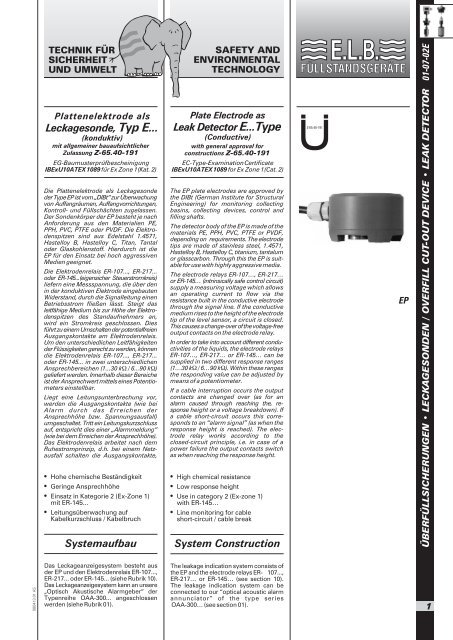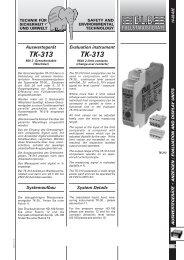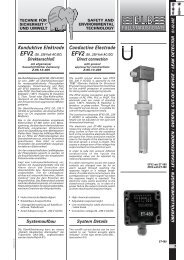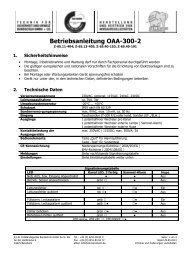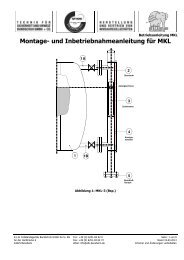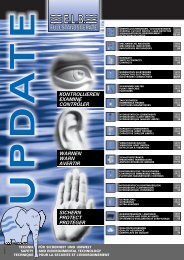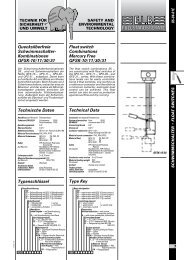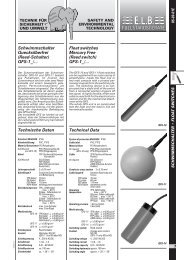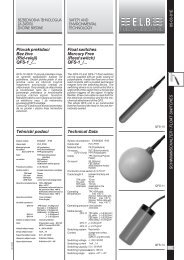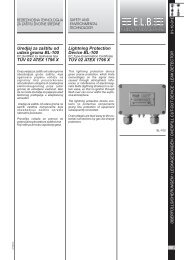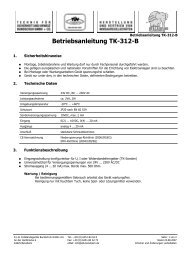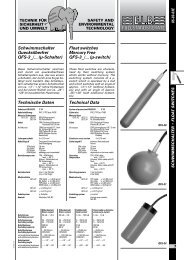01-07-02 - E.L.B. Füllstandsgeräte Bundschuh GmbH+Co.
01-07-02 - E.L.B. Füllstandsgeräte Bundschuh GmbH+Co.
01-07-02 - E.L.B. Füllstandsgeräte Bundschuh GmbH+Co.
You also want an ePaper? Increase the reach of your titles
YUMPU automatically turns print PDFs into web optimized ePapers that Google loves.
TECHNIK FÜR<br />
SICHERHEIT<br />
UND UMWELT<br />
SAFETY AND<br />
ENVIRONMENTAL<br />
TECHNOLOGY<br />
FÜLLSTANDSGERÄTE<br />
<strong>01</strong>-<strong>07</strong>-<strong>02</strong>E<br />
Plattenelektrode als<br />
Leckagesonde, Typ E...<br />
(konduktiv)<br />
mit allgemeiner bauaufsichtlicher<br />
Zulassung Z-65.40-191<br />
EG-Baumusterprüfbescheinigung<br />
IBExU10ATEX 1089 für Ex Zone 1(Kat. 2)<br />
Die Plattenelektrode als Leckagesonde<br />
der Type EP ist vom „DIBt“ zur Überwachung<br />
von Auffangräumen, Auffangvorrichtungen,<br />
Kontroll- und Füllschächten zugelassen.<br />
Der Sondenkörper der EP besteht je nach<br />
Anforderung aus den Materialien PE,<br />
PPH, PVC, PTFE oder PVDF. Die Elektrodenspitzen<br />
sind aus Edelstahl 1.4571,<br />
Hastelloy B, Hastelloy C, Titan, Tantal<br />
oder Glaskohlenstoff. Hierdurch ist die<br />
EP für den Einsatz bei hoch aggressiven<br />
Medien geeignet.<br />
Die Elektrodenrelais ER-1<strong>07</strong>..., ER-217...<br />
oder ER-145...(eigensicher Steuerstromkreis)<br />
liefern eine Messspannung, die über den<br />
in der konduktiven Elektrode eingebauten<br />
Widerstand, durch die Signalleitung einen<br />
Betriebsstrom fließen lässt. Steigt das<br />
leitfähige Medium bis zur Höhe der Elektrodenspitzen<br />
des Standaufnehmers an,<br />
wird ein Stromkreis geschlossen. Dies<br />
führt zu einem Umschalten der potentialfreien<br />
Ausgangskontakte am Elektrodenrelais.<br />
Um den unterschiedlichen Leitfähigkeiten<br />
der Flüssigkeiten gerecht zu werden, können<br />
die Elektrodenrelais ER-1<strong>07</strong>..., ER-217...<br />
oder ER-145... in zwei unterschiedlichen<br />
Ansprechbereichen (1...30 k/ 6...90 k)<br />
geliefert werden. Innerhalb dieser Bereiche<br />
ist der Ansprechwert mittels eines Potentiometers<br />
einstellbar.<br />
Liegt eine Leitungsunterbrechung vor,<br />
werden die Ausgangskontakte (wie bei<br />
Alarm durch das Erreichen der<br />
Ansprechhöhe bzw. Spannungsausfall)<br />
umgeschaltet. Tritt ein Leitungskurzschluss<br />
auf, entspricht dies einer „Alarmmeldung“<br />
(wie bei dem Erreichen der Ansprechhöhe).<br />
Das Elektrodenrelais arbeitet nach dem<br />
Ruhestromprinzip, d.h. bei einem Netzausfall<br />
schalten die Ausgangskontakte,<br />
Hohe chemische Beständigkeit<br />
Geringe Ansprechhöhe<br />
Einsatz in Kategorie 2 (Ex-Zone 1)<br />
mit ER-145...<br />
Leitungsüberwachung auf<br />
Kabelkurzschluss / Kabelbruch<br />
Systemaufbau<br />
Plate Electrode as<br />
Leak Detector E...Type<br />
(Conductive)<br />
with general approval for<br />
constructions Z-65.40-191<br />
EC-Type-Examination Certificate<br />
IBExU10ATEX 1089 for Ex Zone 1(Cat. 2)<br />
The EP plate electrodes are approved by<br />
the DIBt (German Institute for Structural<br />
Engineering) for monitoring collecting<br />
basins, collecting devices, control and<br />
filling shafts.<br />
The detector body of the EP is made of the<br />
materials PE, PPH, PVC, PTFE or PVDF,<br />
depending on requirements. The electrode<br />
tips are made of stainless steel, 1.4571,<br />
Hastelloy B, Hastelloy C, titanium, tantalum<br />
or glasscarbon. Through this the EP is suitable<br />
for use with highly aggressive media.<br />
The electrode relays ER-1<strong>07</strong>…, ER-217…<br />
or ER-145… (intrinsically safe control circuit)<br />
supply a measuring voltage which allows<br />
an operating current to flow via the<br />
resistance built in the conductive electrode<br />
through the signal line. If the conductive<br />
medium rises to the height of the electrode<br />
tip of the level sensor, a circuit is closed.<br />
This causes a change-over of the voltage-free<br />
output contacts on the electrode relay.<br />
In order to take into account different conductivities<br />
of the liquids, the electrode relays<br />
ER-1<strong>07</strong>…, ER-217… or ER-145… can be<br />
supplied in two different response ranges<br />
(1…30 k/ 6…90 k). Within these ranges<br />
the responding value can be adjusted by<br />
means of a potentiometer.<br />
If a cable interruption occurs the output<br />
contacts are changed over (as for an<br />
alarm caused through reaching the‚ response<br />
height or a voltage breakdown). If<br />
a cable short-circuit occurs this corresponds<br />
to an “alarm signal” (as when the<br />
response height is reached). The electrode<br />
relay works according to the<br />
closed-circuit principle, i.e. in case of a<br />
power failure the output contacts switch<br />
as when reaching the response height.<br />
High chemical resistance<br />
Low response height<br />
Use in category 2 (Ex-zone 1)<br />
with ER-145…<br />
Line monitoring for cable<br />
short-circuit / cable break<br />
System Construction<br />
Z-65.40-191<br />
EP<br />
ÜBERFÜLLSICHERUNGEN • LECKAGESONDEN / OVERFILL CUT-OUT DEVICE • LEAK DETECTOR<br />
080413.<strong>01</strong> AS<br />
Das Leckageanzeigesystem besteht aus<br />
der EP und den Elektrodenrelais ER-1<strong>07</strong>...,<br />
ER-217... oder ER-145... (siehe Rubrik 10).<br />
Das Leckageanzeigesystem kann an unsere<br />
„Optisch Akustische Alarmgeber“ der<br />
Typenreihe OAA-300... angeschlossen<br />
werden (siehe Rubrik <strong>01</strong>).<br />
The leakage indication system consists of<br />
the EP and the electrode relays ER- 1<strong>07</strong>...,<br />
ER-217… or ER-145… (see section 10).<br />
The leakage indication system can be<br />
connected to our “optical acoustic alarm<br />
annunciator” of the type series<br />
OAA-300… (see section <strong>01</strong>).<br />
1
<strong>01</strong>-<strong>07</strong>-<strong>02</strong>E<br />
ÜBERFÜLLSICHERUNGEN • LECKAGESONDEN / OVERFILL CUT-OUT DEVICE • LEAK DETECTOR<br />
E<br />
Technische Daten Technical Data Maßbild<br />
Dimensional Drawing<br />
Schutzart EN 60529<br />
Material<br />
Sondenkörper<br />
Kabel<br />
Auf Wunsch<br />
Kabellänge<br />
Material Fühlerstäbe<br />
Betriebstemperatur<br />
Betriebsdruck<br />
Widerstandswert der<br />
Leitungsüberwachung<br />
Typenschlüssel<br />
Grundbezeichnung<br />
IP 68<br />
PPH, PVC, PE,<br />
PVDF, PTFE<br />
TPK (PVC Basis)<br />
FEP (Teflon)<br />
EX (PVC blau)<br />
auf Wunsch<br />
Edelstahl (1.4571),<br />
Hastelloy B, Hastelloy C,<br />
Titan, Tantal,<br />
Glaskohlenstoff<br />
atmosphärisch<br />
atmosphärisch<br />
Material des Sondenkörpers<br />
PP = Polypropylen<br />
PE = Polyethylen<br />
PV = Polyvinylchlorid<br />
PT = Polytetrafluorethylen<br />
PVDF = Polyvinylidenfluorid<br />
Stabmaterial<br />
VA = Edelstahl (1.4571)<br />
HB = Hastelloy B<br />
HC = Hastelloy C<br />
TI = Titan<br />
TA = Tantal<br />
KO = Glaskohlenstoff<br />
22 k/ 100 k<br />
je nach Ausführung<br />
Kabellänge in m<br />
<strong>01</strong> = 1 m<br />
<strong>02</strong> = 2 m usw.<br />
Widerstand der<br />
Leitungsüberwachung<br />
000 = kein Widerstand<br />
(ohne Prüfzeichen)<br />
<strong>02</strong>2 = 22 k(mit Prüfzeichen)<br />
100 = 100 k(mit Prüfzeichen)<br />
Kabelmaterial<br />
ohne Angabe = TPK<br />
FEP= Teflon<br />
EX = PVC blau<br />
Auf Wunsch:<br />
EX=<br />
Ex II 2G Ex ib IIB T4 Gb<br />
System of protection<br />
EN 60529<br />
Material probe body<br />
Cable<br />
On request<br />
Cable length<br />
Material<br />
sensor rods<br />
Operating temperature<br />
Operating pressure<br />
Resistance of the<br />
line monitoring<br />
E<br />
Basic designation<br />
IP 68<br />
PPH, PVC, PE,<br />
PVDF, PTFE<br />
TPK (PVC basis)<br />
FEP (Teflon)<br />
EX (PVC blue)<br />
on request<br />
Stainless steel (1.4571),<br />
Hastelloy B, Hastelloy C,<br />
Titanium, Tantalum,<br />
Glasscarbon<br />
atmospheric<br />
atmospheric<br />
22 k/ 100 k<br />
according to the type<br />
Type Key<br />
Material of the leak detector<br />
PP = Polypropylene<br />
PE = Polyethylene<br />
PV = Polyvinylchloride<br />
PT = Polytetrafluorethylene<br />
PVDF = Polyvinylidenfluoride<br />
Rod material<br />
VA = Stainless steel (1.4571)<br />
HB = Hastelloy B<br />
HC = Hastelloy C<br />
TI = Titanium<br />
TA = Tantalum<br />
KO = Glasscarbon<br />
Cable length in m<br />
<strong>01</strong> = 1 m<br />
<strong>02</strong> = 2 m etc.<br />
Resistance of the<br />
line monitoring<br />
000 = no resistance<br />
(without check symbol)<br />
<strong>02</strong>2 = 22 k (with check symbol)<br />
100 = 100 k<br />
(with check symbol)<br />
Cable material<br />
without indication = TPK<br />
FEP= Teflon<br />
EX = PVC blue<br />
Auf Wunsch:<br />
EX=<br />
Ex II 2G Ex ib IIB T4 Gb<br />
Plattenelektroden in Reihe / Plate electrodes in series<br />
E0<br />
E1<br />
E0<br />
E1<br />
Slave 1<br />
E0<br />
E1<br />
E0<br />
E1<br />
Slave 2<br />
Slave-Elektroden für Reihenschaltung = Slave 1, 2, ..usw.<br />
Slave-electrodes for series cercuit = Slave 1, 2, ..etc.<br />
35<br />
Ø56<br />
Ø11<br />
M6<br />
M12x1.5<br />
Bemaßung in mm / Dimensioning in mm<br />
E0<br />
E1<br />
E0<br />
E1<br />
End-Slave n<br />
100 k<br />
mit Abschlusswiderstand<br />
with terminator<br />
5<br />
L: Kabellänge<br />
Cable length<br />
3,5<br />
max. 100 m innerhalb eines Raumes<br />
max. 100 m within a room<br />
Irrtümer und Änderungen vorbehalten.<br />
Subject to change without prior notice, errors excepted.<br />
2<br />
BUNDSCHUH GMBH & CO. KG<br />
An der Hartbrücke 6<br />
D-64625 Bensheim<br />
Telefon: +49 (0)6251 8462-0<br />
Fax: +49 (0)6251 8462-72<br />
E-Mail: info@elb-bensheim.de<br />
Info: www.elb-bensheim.de<br />
080413.<strong>02</strong> AS<br />
FÜLLSTANDSGERÄTE


